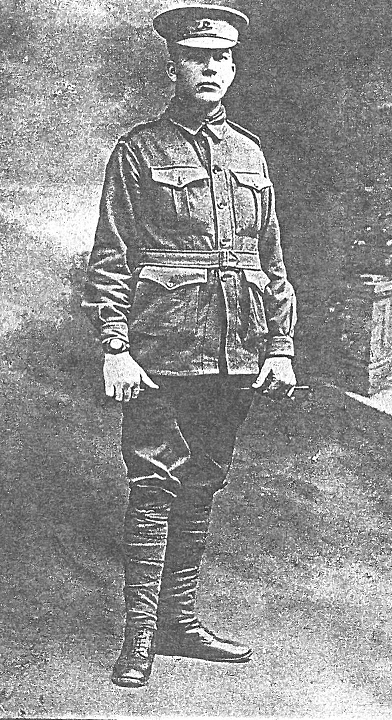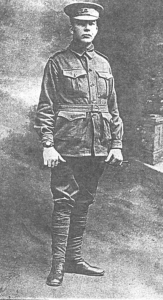Wilfred Edmund Cox was born in Orange on 11 May 1881, the ninth of thirteen children of James Cox and Eliza Hasemer. James Cox had emigrated to Australia in 1849, aged just 13, and learnt the trade of brickmaking. He settled in Orange in 1863, where he established a brickworks. James created the bricks used to construct the Holy Trinity Church in 1878. He was church warden for many years and also served as an alderman on Orange Municipal Council.
Wilfred was educated at Orange Public School and later entered the family business as a brick labourer.
On 30 January 1904 Wilfred married Alice Maud Clark of Wattle Flat at Enmore; their son Wilfred James was born in June that year. The couple settled in Parramatta.
Wilfred enlisted for war service on 12 October 1915, stating on his attestation papers that he had served for six years in the 3d Infantry. A private in the 13th Battalion, 20th Reinforcement C Company, Wilfred did not embark for overseas service until September 1916.
Private Cox disembarked in Plymouth on 26 October 1916 and proceeded to the 4th Training Battalion at Codford. In late December he was assigned to the Western Front. He served for just a month before being admitted to the 4th Australian Field Ambulance with trench foot. He rejoined his unit on 13 February 1917, but was hospitalised again on 4 April with influenza.
Later that month Wilfred was transferred to the Richmond Military Hospital in England with trench fever. He convalesced at the 1st Auxiliary Hospital at Harefield before reporting to Weymouth Depot on 28 July 1917.
Wilfred returned to France in early 1918, rejoining the 13th Battalion at Havre on 7 January. At the beginning of March 1918 the 13th Battalion was engaged at the front line near Ypres. On 3 March they moved to billets at Neuve Eglise where they spent the next three weeks recuperating and undertaking musketry and specialist training.
An entry in the unit diary for 22 March states “billets at Neuve Eglise being shelled”. On that morning the battalion was engaged in range practice, and in the afternoon, recreational training. According to an eyewitness, Private John Gaffney, Wilfred was one of fourteen men engaged in a tug-o-war when they were struck by an enemy shell. Five of them were killed, Wilfred included.
Wilfred was buried in the nearby Nieuwkerke (Neuve Eglise) Churchyard.
Wilfred’s obituary in the Cumberland Argus and Fruitgrowers Advocate on 13 April 1918 described him as “a magnificent specimen of the Australian native, standing 6ft. 1in. in his stockings”.
Wilfred Edmund Cox in commemorated on the World War I Roll of Honour on the southern face of the Orange Cenotaph and on panel number 68 on the Roll of Honour at the Australian War Memorial in Canberra.
In 1923 the Anzac Memorial Avenue of trees was planted along Bathurst Road to commemorate fallen WWI soldiers. A tree was planted in honour of “Pte WE Cox”; it was donated by JH Hawke. Very few of the trees are still standing today.


